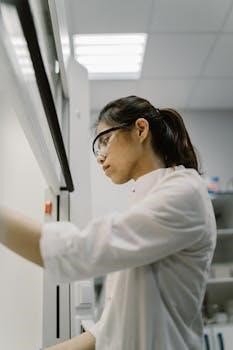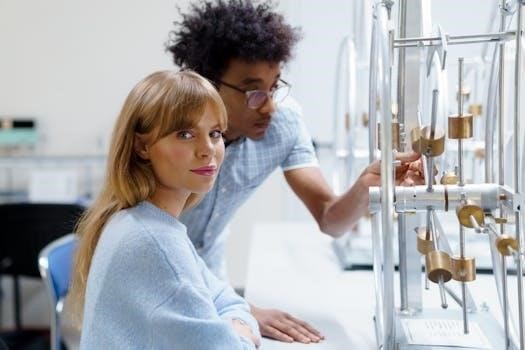
Physics lab manuals are essential resources for students, providing a structured approach to hands-on learning. They guide experiments, offer background, and detail procedures. These manuals enable students to engage with physical concepts through practical applications.
Purpose of a Physics Lab Manual
The primary purpose of a physics lab manual is to facilitate effective hands-on learning experiences. It serves as a comprehensive guide, detailing each experiment’s objectives and theoretical background, thereby bridging the gap between abstract concepts and practical application. These manuals outline clear procedures to ensure experiments are conducted safely and accurately, while also providing guidance on data collection, analysis, and interpretation. Moreover, lab manuals often incorporate pre-lab activities to stimulate thinking about the experiment before its execution, fostering a deeper understanding of the underlying principles. The manuals also encourage students to critically evaluate results and draw conclusions, which are crucial for scientific reasoning. Ultimately, a physics lab manual empowers students to actively engage with the scientific method, developing essential skills in observation, measurement, and analysis. Finally, the lab manual promotes the use of lab notebooks for recording procedures and data, which is an important habit for a scientist.
Importance of Pre-Lab Activities
Pre-lab activities in a physics lab manual are crucial for maximizing learning outcomes. These activities prepare students for the hands-on experience by requiring them to understand the theoretical concepts and procedures before entering the lab. This preparation helps students conduct experiments more efficiently and effectively, allowing them to focus on data collection and analysis rather than struggling with basic procedures. Pre-labs often include questions or problems that encourage students to think critically about the experiment, enabling them to make informed predictions about the expected results. Furthermore, completing the pre-lab activities fosters a sense of preparedness, reducing the risk of errors or accidents during the actual experiment. By engaging with pre-lab materials, students can also identify any areas where they need clarification, promoting a more productive and insightful laboratory session. Ultimately, pre-lab activities are an essential component of physics education, ensuring that students are equipped with the necessary knowledge to truly benefit from hands-on experimentation and to relate their theoretical knowledge with practical skills. The pre-lab also encourages independent studying of the topic.
Key Components of a Physics Lab Manual
A physics lab manual typically includes experiment descriptions, equipment lists, data collection guidance, and post-lab questions. These elements ensure a structured and effective learning experience for students.
Experiment Descriptions and Procedures
Experiment descriptions within a physics lab manual provide a concise overview of each experiment’s objective and theoretical foundation. This section elaborates on the concepts being explored, often referencing relevant textbook material to reinforce understanding. Detailed procedural steps are outlined, ensuring students can replicate the experiment accurately. Clear instructions on setting up equipment, performing measurements, and recording data are crucial aspects of this section. The manual also includes guidance on minimizing errors and promoting safety. Furthermore, experiment descriptions often incorporate pre-lab questions designed to engage students with the concepts. These questions encourage students to anticipate results and focus the purpose of the experiment. Finally, this section sets the stage for effective data analysis and interpretation, ensuring students can learn from their findings.

Equipment and Setup Instructions
This section of the physics lab manual meticulously details the equipment required for each experiment, ensuring students know precisely what tools and materials they will be using. It provides a comprehensive list of items, including specific models or types when necessary, which aids in preparation and organization. Detailed diagrams and illustrations often accompany the text to visually demonstrate the correct arrangement of the equipment, reducing the likelihood of errors during setup. Step-by-step instructions guide the student through the process of connecting and configuring the apparatus. The manual also specifies power requirements and calibration procedures, ensuring accurate measurements. Safe operating instructions are also included to mitigate the risk of damage or injury. Precise instructions ensure that students can begin their experiments efficiently and focus on the learning objectives of the session. Finally, this element makes sure that the lab setup is consistent and reliable.

Data Collection and Analysis Guidance
This critical section of the physics lab manual provides clear instructions on how to gather and interpret experimental data. It emphasizes the importance of accurate and precise measurements, guiding students on the correct usage of measuring instruments. The manual outlines the specific data points to be collected, often including tables or charts for organized recording. It also specifies units of measurement and the number of significant figures required. Furthermore, this section details how to perform data analysis, including calculations, error analysis, and the creation of graphs. It provides formulas, equations, and step-by-step processes for processing raw data. Students are often guided on the use of software tools for graphing and statistical analysis. This helps students understand the link between data collection and theoretical concepts. Ultimately, this section ensures students can effectively analyze the data obtained in the lab and draw conclusions based on their results and helps to make sure that the data is handled properly and correctly.
Post-Lab Questions and Reporting
The post-lab section of a physics lab manual is crucial for reinforcing learning and assessing comprehension. It includes a set of questions designed to encourage critical thinking about the experiment and the underlying physics concepts. These questions require students to analyze their data, explain any deviations from expected results, and connect their findings to the broader theoretical framework. The section also provides guidelines on how to write a detailed lab report. Students are expected to summarize their methods, present their data clearly, and discuss their results in a scientific manner. The report often includes sections like an introduction, procedure, data, analysis, and conclusions. Students are required to discuss experimental errors and uncertainties, as well as make suggestions for future improvements. The reporting guidelines make it easier to write lab reports in a consistent format, and also helps students to develop their scientific writing skills. This section helps students to synthesize what they learned, and demonstrate their understanding of the experiment. The section also ensures that students can communicate their findings effectively.
Essential Elements for Lab Success
Lab success hinges on preparation, proper notebook use, and safety. Thorough pre-lab work is crucial, alongside careful data recording. Adhering to safety guidelines ensures a secure learning environment.

Preparation Before Lab Sessions
Effective preparation before lab sessions is paramount for a successful and enriching learning experience. Students should begin by thoroughly reviewing the lab manual, familiarizing themselves with the experiment’s objectives, theoretical background, and procedural steps. Pre-lab activities, often included at the beginning of each lab in the manual, must be completed before attending the session. This preparation includes understanding the experimental setup and equipment, which may involve studying diagrams and instructions provided. It is also crucial to formulate predictions about the expected results, which can be recorded in the lab manual. Furthermore, students must bring necessary materials, such as a bound lab notebook, a scientific calculator, pens, and pencils. Some labs may require a laptop with spreadsheet software, so students should be aware of these additional needs. This preparation ensures students understand the physics behind the experiment, allowing them to participate actively and efficiently in the lab session.
Proper Use of Lab Notebook
The proper use of a lab notebook is a cornerstone of scientific practice and is vital for physics lab sessions. A bound, quadrille-ruled notebook is typically required to ensure data integrity and organization. Before starting any experiment, students should record the date, experiment title, and objectives. Throughout the lab, all observations, measurements, and procedures must be meticulously documented in the notebook. This documentation should be clear, detailed, and recorded in real-time. It’s essential to avoid erasing mistakes; instead, draw a single line through errors and write the correction nearby. Data should be recorded with proper units and uncertainties. Diagrams of the experimental setup should also be included. The lab notebook serves as a primary record of the experiment, so it should be organized and easy to follow. Post-lab analysis, calculations, and conclusions should be added to the notebook, making it a comprehensive log of the entire experiment and a reference for future study.
Safety Guidelines and Regulations
Safety guidelines and regulations are paramount in any physics laboratory setting. Strict adherence to these rules is crucial to prevent accidents and ensure a safe working environment. Students must familiarize themselves with all safety protocols outlined in the lab manual and by their instructor before commencing any experiment. Proper attire, such as closed-toe shoes and appropriate clothing, is required. Eating, drinking, and applying makeup are strictly prohibited in the lab. It is essential to handle lab equipment with care and report any damaged or malfunctioning apparatus immediately. When using electrical equipment, students should be cautious to avoid electrical shock. They should also be aware of potential hazards related to chemicals or lasers and follow the proper procedures for handling these. In case of an emergency, students must know the location of safety equipment like fire extinguishers, first-aid kits, and emergency exits. Students should always work under supervision and never perform unauthorized experiments. Proper disposal of waste materials is also vital. By following these guidelines, everyone can contribute to a safe and productive lab environment.
Advanced Topics in Lab Manuals
Advanced manuals include inquiry-based experiments, encouraging student-led investigations. They delve into modern physics topics, incorporating data interpretation and graphing techniques. These resources foster deeper understanding and critical analysis.
Inquiry-Based Experiments
Inquiry-based experiments, a cornerstone of advanced physics lab manuals, shift the focus from rote procedures to student-driven exploration. These experiments encourage learners to formulate their own questions, design experimental approaches, and analyze their findings. Unlike traditional labs with prescribed steps, inquiry-based activities promote critical thinking and problem-solving abilities. Pre-assessment questions often precede these experiments, prompting students to think about the underlying physics principles. The structure of these labs supports students in making predictions and developing their own experimental methods. This hands-on engagement helps to satisfy their curiosity and deepen their understanding of physics concepts. Students are not only replicating a known outcome, but are actively involved in the process of discovery. Through this method, the lab manual becomes a tool for exploration, rather than just a set of instructions. Ultimately, inquiry-based experiments foster a more profound and memorable learning experience, preparing students for real-world scientific challenges. The aim is to empower students to become independent thinkers and researchers.
Modern Physics Experiments
Modern physics experiments, often included in advanced lab manuals, delve into the groundbreaking discoveries of the 20th century and beyond. These experiments often explore concepts like quantum mechanics, relativity, and atomic structure. They introduce students to phenomena beyond the scope of classical mechanics, such as the behavior of electrons and photons. Lab manuals for these experiments may include investigations of the photoelectric effect, the Franck-Hertz experiment, or the properties of lasers. Due to the abstract nature of these concepts, the lab manuals often provide detailed background information and theoretical frameworks. Students use specialized equipment to observe and measure quantum phenomena, developing a deeper understanding of the fundamental nature of reality. These experiments require careful data analysis and interpretation to connect experimental results with theoretical predictions. Modern physics experiments aim to bridge the gap between theoretical knowledge and experimental observation, emphasizing the crucial role of experimentation in scientific progress. Such exercises offer students a glimpse into the ongoing research and advancements in the world of physics. Ultimately, they build a foundation for future studies in advanced physics.
Data Interpretation and Graphing
A critical aspect of physics lab manuals involves guiding students through effective data interpretation and graphing techniques. This section emphasizes the importance of accurately recording experimental results and presenting them in a clear and understandable format. Lab manuals often provide detailed instructions on constructing graphs, including choosing appropriate scales, labeling axes, and plotting data points with error bars. Students are taught how to analyze data for trends and relationships between variables, using techniques such as linear regression and curve fitting. Furthermore, manuals guide students in interpreting the physical significance of the data, drawing conclusions based on evidence and the theory involved. They may also include guidance on using software, such as spreadsheets, to create graphs and perform statistical analyses. Proper data interpretation involves understanding both the limitations of experimental data and the uncertainties involved in measurements. These skills are essential for developing a deep understanding of physical concepts and communicating results effectively. The goal is to transform raw data into meaningful insights, which allows for critical evaluation of experimental findings and promotes scientific literacy.

Leave a Reply
You must be logged in to post a comment.